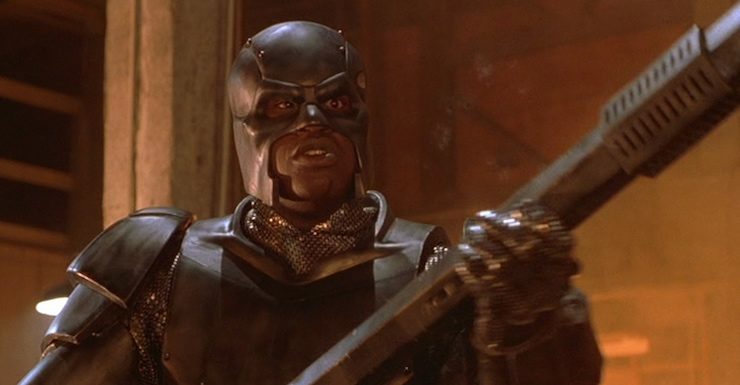The seeds of this week’s superhero movie rewatch—both 1997 releases—were sown in 1992.
At DC, there were four monthly titles starring Superman: Action Comics, The Adventures of Superman, Man of Steel, and Superman. In ’92, “The Death of Superman” was the major storyline running through all four titles, culminating in the man of steel’s death at the hands of Doomsday. Four heroes took on the mantle of Superman following his death, one in each of those titles. In Man of Steel by Louise Simonson & Jon Bogdanove, they focused on John Henry Irons, a ballistics expert who created a suit of armor and called himself Steel.
At Marvel, several of the company’s most popular artists—Jim Lee, Rob Liefeld, Marc Silvestri, Erik Larsen, and Todd McFarlane—left Marvel to form their own creator-owned company, Image Comics. McFarlane’s contribution to Image’s first wave of titles was a dark hero known as Spawn.
Both heroes starred in their own live-action movies five years after their debuts.
Steel was the only one of the four “Supermen” who wasn’t claiming to be the original. Superboy was a clone of Superman and Lex Luthor. The Last Son of Krypton and the Cyborg Superman both claimed to be the original, albeit changed—the former was, in fact, the Eradicator, a Kryptonian artifact that programmed itself to believe it was Superman, while the latter was a villain named Hank Henshaw running a long con.
Irons, though, was simply in it as a tribute to Superman, using his scientific skills to construct a suit of armor that would enable him to be a hero in the mode of Superman. After Superman returned, he removed the logo from his armor’s chest and continued as Steel.
Spawn was a creation of McFarlane, who had made his bones as an artist, and later writer/artist, of Spider-Man. A former Marine who did black ops for the CIA, Al Simmons comes back from hell as a spirit of vengeance of sorts.
Both characters are African-American, both characters were born of major events in the comics industry, and both characters had 1997 live-action films that disappointed mightily at the box office. Steel was written and directed by Kenneth Johnson (of The Incredible Hulk, V, and The Bionic Woman fame), while Spawn was a collaboration between horror screenwriter Alan B. McElroy and first-time director Mark A.Z. Dippé.
(Also both characters were better served by animation—Spawn was also a long-running animated series on HBO that got its own spinoff movie, with Keith David providing the lead voice, and on which McElroy also worked; Steel was part of the DC Animated Universe, appearing in both Superman: The Animated Series and Justice League Unlimited, voiced by, respectively, Michael Dorn and Phil LaMarr.)
“I never could make free-throws”
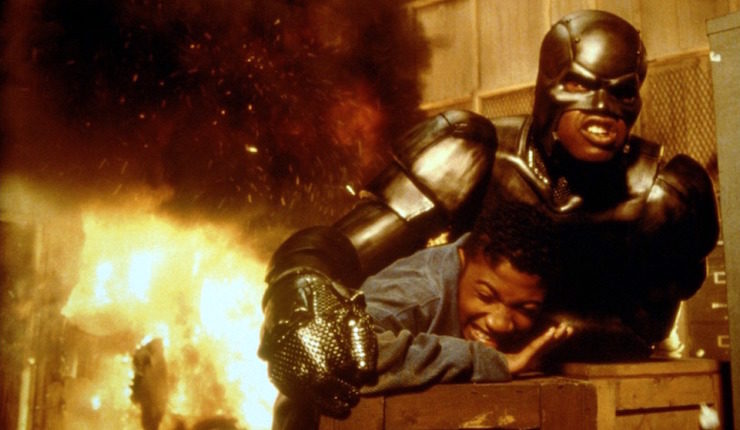
Steel
Written and directed by Kenneth Johnson
Produced by Quincy Jones & David Salzman & Joel Simon
Original release date: August 15, 1997
The Army is testing new laser and sonic weapons made by a team under the command of Colonel David. Said team includes Lieutenants John Henry Irons, Susan Sparks, and Nathaniel Burke. They’re doing a demo for a U.S. senator, and Burke decides to impress the senator by turning the sonic setting to its highest level. It hasn’t been tested at that level, though, and the backwash destroys the building they’re in. The senator is killed, Sparks is maimed, left paraplegic by rubble crushing her spine, and Burke is court-martialed. He inexplicably is only dishonorably discharged, not imprisoned. Irons resigns his commission, while Sparks is sent to a VA hospital.
Irons returns home to Los Angeles, reunited with his baby brother Martin, his grandmother Odessa, and his uncle Joe. He gets a job as a welder, tries to keep Martin on the straight-and-narrow, and watches his grandmother try to meld French cooking with soul food.
Burke also arrives in L.A., hooking up with a colleague who owns a video arcade and uses it as a front for weapons sales. He wants to use the dealer’s resources to re-construct the laser and sonic weapons and sell them to the highest bidder. The initial test wounds the person testing it, and the dealer’s assistant is not pleased. Burke retaliates by blowing up an elevator she’s in. This inexplicably gets the security chief on Burke’s side and doesn’t alienate the arms dealer. (Nor does anyone in law-enforcement appear to investigate this triple homicide—there were two innocent bystanders in the elevator.) Burke also makes sure to hire Martin to work for him, as he wants to stick it to Irons, who testified against him at the court-martial.
Burke uses a street gang to field test the weapons by robbing a bank. A cop friend of Irons is escorting him and Martin to a community meeting when the robbery call comes in. The cop is wounded, and Irons, recognizing the weapons used, gives chase to one robber who got left behind. The kid refuses to give up where he got the weapons and gets away.
Sparks is rotting in a VA hospital in St. Louis. Irons springs her and brings her to Uncle Joe’s junkyard. Together, they fashion a suit of armor for Irons to wear so he can stop the weapons from hurting anyone else. Once he welds the armor and Sparks provides the tech (with Joe providing the parts that are fresh off the truck they fell off of, ahem), he goes out and stops a few muggers and gang-bangers before taking on Burke’s gang, who have very generously waited until Irons made and tested his armor and hammer before striking again. Irons is unable to stop them.
While Burke puts the word out on the Internet that he’s auctioning these weapons off to the highest bidder, Irons is arrested, since the cops think he’s part of the gang. (It doesn’t help that Irons runs from the cops and even attacks them, however lightly.) Sparks and Joe manage to engineer an escape by spoofing the voice of the district attorney, and then Irons armors up and goes after Burke—but Burke has kidnapped Sparks and holds her hostage to keep Irons in line. However, Irons tricks Burke into activating the electromagnet in the hammer, and Sparks has tricked out her wheelchair with weapons of its own. They’re able to escape. Burke is killed when his laser is reflected back on him when he fires on the armored Irons.
The weapons are confiscated and off the streets, and Irons says he’s retiring from the hero business, and they go to Odessa’s new restaurant to celebrate.
“How come God gets all the good followers and we get the retards?”
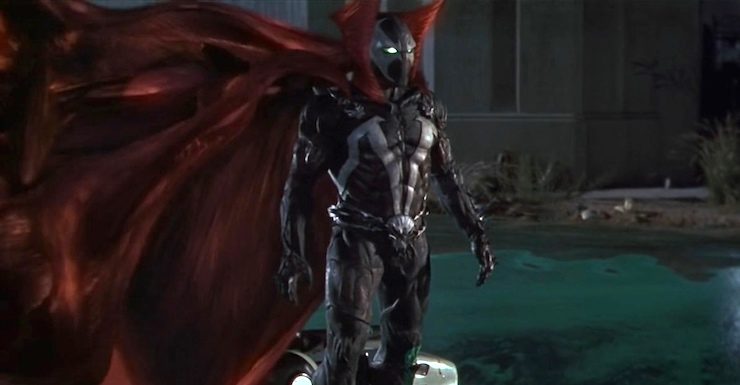
Spawn
Written by Alan B. McElroy and Mark A.Z. Dippé
Directed by Mark A.Z. Dippé
Produced by Clint Goldman
Original release date: August 1, 1997
Lt. Colonel Al Simmons is doing black ops work for a government agency known as A-6, run by an immoral asshole named Jason Wynn. After assassinating a dictator that results in collateral damage to civilians, Simmons says he wants out. Wynn reluctantly agrees, but just-one-more-jobs him, sending him to North Korea to destroy a biological weapon. Except when he arrives, he finds Wynn and his other top agent, Jessica Priest, there. They burn him alive and blow up the facility, letting loose the bio-weapon on a local city.
Simmons dies and goes to hell, returning five years later covered in burns, and thinking that he only just died in Korea. His memory is restored by a demonic clown—who is also working with Wynn. Malebolgia, the devil, wants Simmons to lead the army of hell to the apocalypse on Earth. In order to prove himself, he must kill Wynn, and if he does so, he’ll get his wife Wanda back. Simmons doesn’t believe it until he digs up his own dead body. (He knows it’s his body because it has the locket with his and Wanda’s pictures, which he holds onto.)
Simmons wants to kill Wynn in any case, as well as Fitzgerald, his best friend who is now married to his wife. They also have a daughter named Cyan. Simmons attacks a reception that Wynn is attending. Fitzgerald now does PR work for A-6, assuring the public that everything’s fine, even though Wynn is using the agency to further his own thirst for power. Wynn plans to sell the bio-weapon, Heat-16, which has been refined and weaponized over the last five years, to the highest bidder.
After raiding A-6’s armory, Simmons attacks a reception that Wynn and Fitzgerald are attending. He kills Priest, but is overwhelmed by A-6 security and the police before escaping.
Another hellspawn soul Malebolgia tried to recruit—a medieval assassin named Cogliostro—tries to convince Simmons to rebel as he did. But all Simmons can think about is getting Wanda back and getting revenge on Wynn.
The clown convinces Wynn to get a pacemaker that will serve as a dead-man switch—if Wynn’s heart stops, Heat-16 will be released all over the world. The clown is playing both sides, hoping that either Simmons will kill Wynn, thus unleashing a genocidal plague, or Wynn will kill Simmons, thus allowing the clown to lead the army of hell in Simmons’s place.
After the clown attacks Simmons in his true form as a demon known as the Violator and leaves him pinned to a fence, Cogliostro rescues Simmons and tries to train him in how to use his hellspawn armor as a weapon of his mind.
He goes to see Wanda and Cyan. Fitzgerald has already learned of Wynn’s plans, and tried to e-mail Wynn’s files to a reporter, but Wynn himself showed up and shot up Fitzgerald’s computer before the e-mail could send. Wynn and the clown take Wanda, Fitzgerald, and Cyan hostage. Simmons and Cogliostro fight them, with the clown taking them to hell directly. Cogliostro manages to wound the clown in his Violator form, while Simmons destroys the hell-army he’s supposed to lead, er, somehow. Malebolgia tells him he can’t leave, and then he and Cogliostro leave. Okay, then.
Simmons pulls the pacemaker out of Wynn, er, somehow, thus ending the threat to the world—though he doesn’t kill Wynn. The Violator takes one last shot at killing him, but Simmons manipulates the chains from his armor to cut off the Violator’s head, which kills the clown permanently.
Wynn is arrested, and Simmons realizes he needs to leave his family alone for them to be safe. But he does leave the locket with Cyan.
“Lookit here, boy, you ain’t Superman”
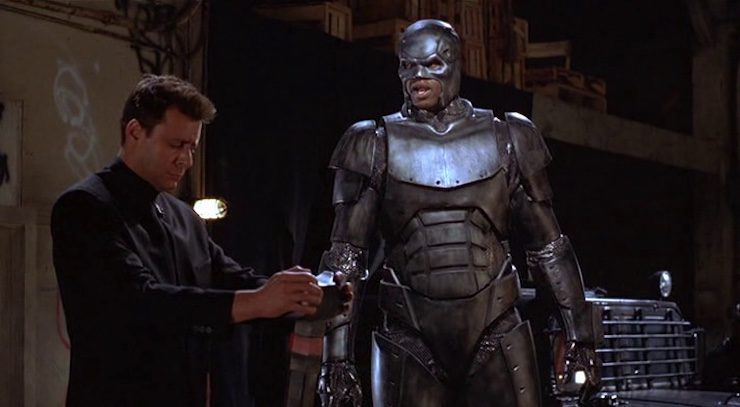
I have to confess to always having had a fondness for the John Henry Irons character. His monthly title, which was written first by his co-creator Simonson, and then by Christopher Priest, was one of my favorites. And of all the pretenders to Superman’s mantle in “Reign of the Supermen,” he was the one I liked best (though Superboy was fun, too).
I can’t really say the same for Spawn, which I could just never get into. McFarlane’s art has always been superb, if a bit stylized, but it was stylized in a way that worked. However, his writing has always left me cold. (I still shudder every time I remember the caption box from his Spider-Man #1 in 1990: “His web line—ADVANTAGEOUS!” Say what?)
But, holy cow, did both their live-action movies suck the wet farts out of dead pigeons.
I watched Steel and thought, “Wow, is this embarrassing,” and then I watched Spawn and didn’t realize when I had it so good. Steel is terrible, but at least it’s harmless—and its heart is in the right place, as ultimately it’s about a hero who does the right thing. (Although the ease with which Steel uses stolen equipment and fights the cops is a bit off-putting.) Spawn, though doesn’t even have heart. It’s just a dank, dark, ugly story about dank, dark, ugly people. John Henry Irons became Steel to keep people from being hurt. Al Simmons became Spawn because he’s good at killing people. While there’s a level of tragedy to Simmons, it’s a pretty shallow level, all told, and he’s mostly an awful person whose notion of a conscience is half-assed and half-hearted.
The primary issue with both movies is that they’re led by gentlemen who act horribly. Michael Jai White can act—he did an excellent job two years prior to this in the title role on the HBO miniseries Tyson, not to mention his brilliant comic turn in Black Dynamite—but he shows no evidence of it here. To be fair, neither do John Leguizamo or Melinda Clarke, who have also given excellent performances elsewhere, but who both are truly dreadful here. Leguizamo in particular is just painful to watch, giggling and goofing and being forced to utter the lamest of lame comic dialogue while wearing a fat suit. The only person actually trying is Martin Sheen, who puts in a delightfully evil performance as Wynn.
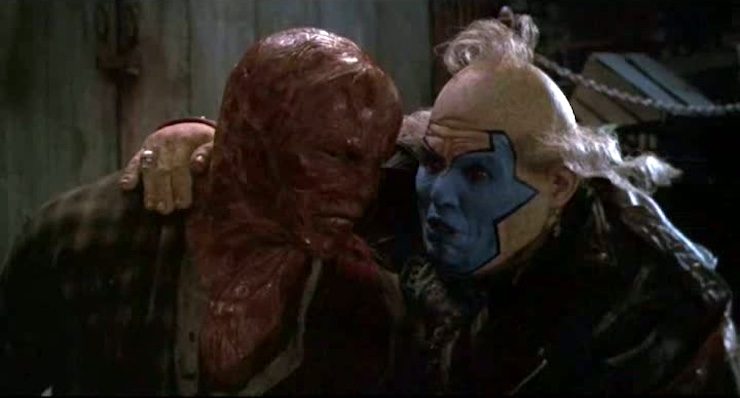
The contrast is far worse in Steel, because Shaquille O’Neal really really really can’t act. His bright smile is infectious, but this was a disastrous casting of a scientist on the same level as Denise Richards in The World is Not Enough or Adam Baldwin in Gargantua. He’s surrounded by some fine talent in Annabeth Gish and Richard Roundtree as the Oracle-like Sparks and Uncle Joe, respectively, which only serves to shine a light on his considerable thespic limitations.
Speaking of thespic limitations, we have Steel’s awful bad guy. Where Sheen is Spawn’s saving grace, Judd Nelson just exacerbates the problems with Steel with a two-dimensional performance of a one-dimensional character. (Hill Harper is much better—and much more fun—as the crazed Slats. I almost didn’t recognize Harper with shaved head and eyepatch…)
Scriptwise, both movies hew pretty closely to the comics. While Steel’s connection to Superman is removed (excepting the Superman tattoo that O’Neil already has, so they make sure to show it a few times), the storyline is pretty much the same as that of the comics, as Irons learns that a weapon he helped develop for the military winds up on the streets used by gangs. (Johnson claimed to have created an entirely new storyline for Steel removed from the comics, but this is blatantly false, as it’s the exact same storyline, with only small details changed.) As for Spawn, it’s pretty much a straight adaptation of the earliest days of the Spawn comic, with only the character of Chapel (who was part of Rob Liefeld’s Youngblood comic, and therefore owned by Liefeld and not McFarlane) changed to Priest, and Fitzgerald cast with a white actor, because heaven forfend we have a movie where all the protagonists are black.
Both movies make reference to other, much better movies that the supporting actors have starred in, with the clown making two different riffs on Apocalypse Now, which Sheen starred in, while Richard Roundtree references his most famous role by talking about how proud he is of the work he did on the shaft of Steel’s hammer.
In addition, both movies suffer greatly from the transition to live-action. Steel’s armor in the comics looks bad-ass; Steel’s armor in live-action looks like a doofy rubber suit. Plus there are holes for the eyes and mouth that look absurd (it’s a full-face helmet in the comics). And while nobody draws a massive, flowing, ragged cape better than Todd McFarlane, in live-action with 1997-level CGI, the cape looks hilariously absurd. (Recognizing this, the filmmakers only have the cape appear sparingly, but every time, it looks awful.) Speaking of 1997-level CGI, every scene in hell is just embarrassing two decades down the line. Malebolgia looks like a monster created on somebody’s home computer after their first graphics class—a class they will go on to fail. (Here’s a hint, folks—if you’re going to have a big-ass demon with a huge mouth and massive teeth, that mouth should really move when he speaks…)
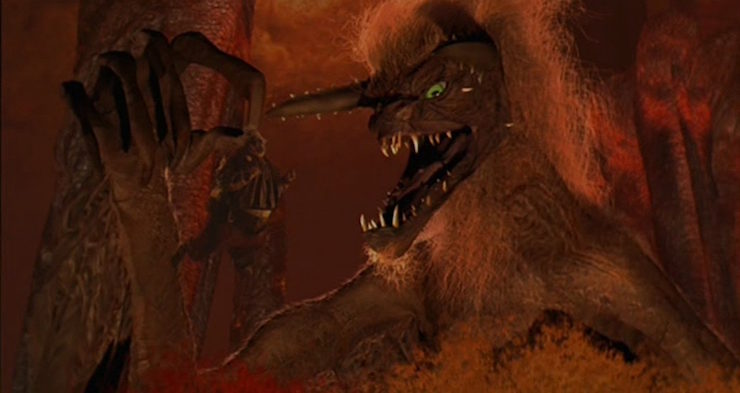
I will give Spawn credit for one thing: Nicol Williamson, in what turned out to be his final film role—he retired from acting after this—gives a restrained performance. That’s an adjective I have never given to any other Williamson role.
Next week, we go from the ridiculous to the sublime, as we examine Howard the Duck and Nick Fury, Agent of S.H.I.E.L.D
Keith R.A. DeCandido urges folks to check out his Patreon, where you can get cat photos, regular TV and movie reviews (he’s reviewed Star Wars: The Last Jedi, Marvel’s Agents of S.H.I.E.L.D., MacGyver, The Librarians, and the Doctor Who Christmas Special), excerpts from his upcoming fiction works, exclusive original vignettes featuring his original characters, and more niftiness.










